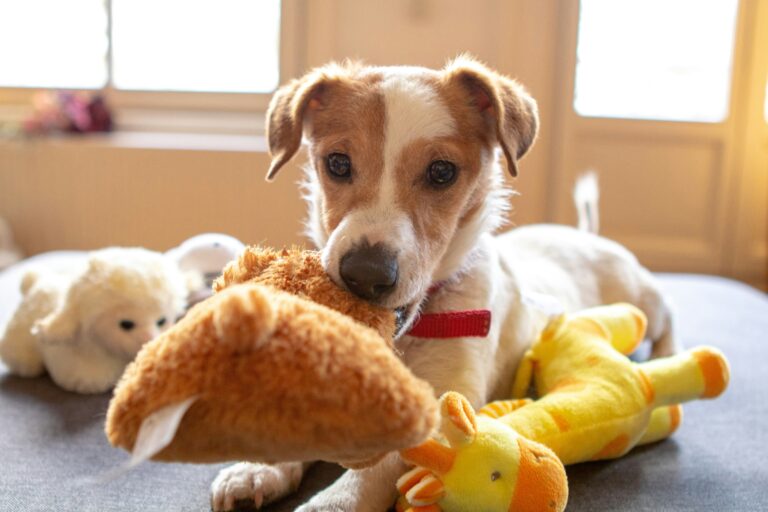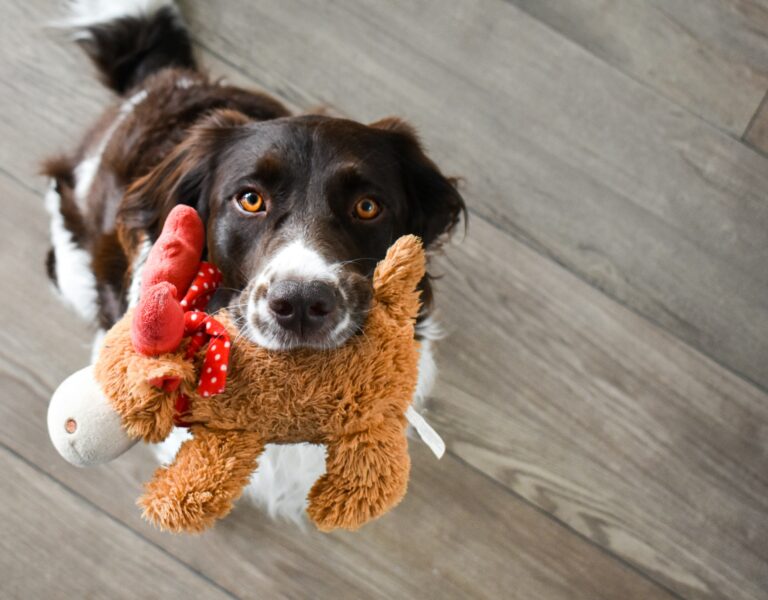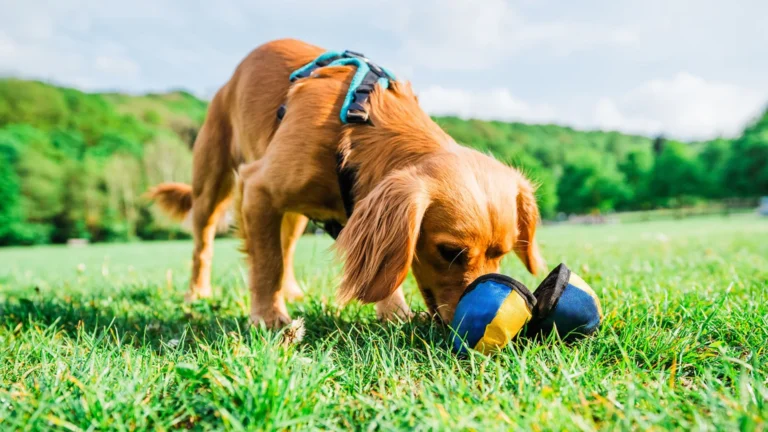In the world of petite pooches, fun and physical activity go hand in hand. Ensuring your little canine companion gets plenty of both is vital for their overall wellbeing. With the right toys, not only can you keep them entertained, but you can also stimulate their minds, satisfy their instinctual needs, and foster a strong bond with them. Welcome to “Playtime Powerhouse: Top 10 Toys to Keep Your Small Dog Active and Happy!” where we’ll walk you through the best playtime companions for your furry friend.
There is an astonishing variety of toys in the market, all designed with a specific purpose – some for chewing, some for fetching, others for tugging. In the quest to find the perfect one for your small dog, it can be easy to get overwhelmed. Fear not, as we’re here to simplify this process. We’ll provide you with an in-depth review of the top 10 toys that are sure to provide endless fun for your small dog while also keeping them fit and happy.
Picking out the right toy is more than just a game of fetch; it’s about understanding your dog’s needs, interests, and safety. So, whether your furry friend is a chewer, a fetcher, a tug-of-war champion, or an explorer, stay tuned! This comprehensive guide is packed with expert advice to help you find the best toy that will keep your small dog active, engaged, and most importantly, overjoyed! 🐾🎾🐶
Physical Health Benefits of Play for Small Dogs
Even though small dogs might not need the same level of physical exertion as larger breeds, daily play is essential for maintaining a healthy body. Engaging in physical activities like fetch, tug, or chase helps burn calories and keep weight in check. Obesity is a common issue among small breeds, particularly those prone to lounging or being carried instead of walked. A consistent play routine combats this by encouraging movement in an enjoyable and natural way.

Beyond weight management, physical activity also supports joint health and muscular development. Light exercise from play helps keep joints lubricated and flexible, reducing the risk of arthritis and mobility issues as your dog ages. This is especially important for breeds like Dachshunds or Pomeranians, which can suffer from spinal or knee problems if under-exercised.
Mental Stimulation Through Play
Mental stimulation is just as vital as physical exercise, especially for intelligent small breeds such as Papillons, Miniature Schnauzers, or Toy Poodles. Without enough mental engagement, these dogs can become bored, anxious, or even develop destructive behaviors such as excessive barking or chewing furniture.
Interactive play acts as a form of brain training. Toys that dispense treats when manipulated, squeaky toys that simulate prey, or games like hide-and-seek with their favorite ball can stimulate your dog’s problem-solving abilities. These activities mimic the challenges dogs would face in the wild, such as hunting for food or navigating new environments.
Even simple games can keep their minds active. For example, rolling a ball under furniture or partially hiding it can make a typical game of fetch more mentally demanding and rewarding.
Building Confidence Through Play
Some small dogs, especially those with timid or anxious temperaments, benefit from confidence-building activities. Play gives them a safe space to explore their surroundings and learn new skills. Every time they master a new toy or solve a puzzle, they experience a sense of accomplishment, boosting their self-esteem.
Confidence gained through interactive play can carry over into other areas of their life. For example, a dog that learns to manipulate a toy for a treat may be more comfortable approaching unfamiliar objects or navigating a new room. Over time, play can help reduce reactivity and fear-based behaviors in shy dogs.
Strengthening the Human-Canine Bond
Playtime is a wonderful opportunity to deepen your connection with your small dog. Active participation in games—whether tossing a toy, giving praise, or hiding treats—teaches your dog that you’re a fun and reliable partner. This interaction builds trust and can improve responsiveness to commands and training outside of play sessions.
Engaging regularly in positive play can also alleviate separation anxiety. A dog that associates you with joyful experiences is more likely to feel secure when you’re nearby, and more trusting that you’ll return after brief absences.
Socialization Through Play
While play is commonly thought of as a solo or one-on-one activity, it can also be a valuable socialization tool. Small dogs benefit from structured interactions with other dogs or people, and toys are often the perfect icebreaker.
Group games at the dog park, supervised indoor playdates, or organized training classes that incorporate play can help your dog become more comfortable around others. Social play also helps dogs learn important behavioral cues like bite inhibition, turn-taking, and communication through body language.
It’s essential, however, to monitor play carefully when your small dog is around larger breeds or more dominant personalities. Ensure the toys used are appropriate for your dog’s size and confidence level, and always supervise to prevent accidental injuries.
Preventing Boredom and Behavioral Problems
Many behavior problems in small dogs stem from unspent energy and lack of stimulation. When dogs are left alone for long periods without toys or interaction, they may start barking excessively, chewing on furniture, or digging. These are signs of boredom and frustration.
Providing your dog with a rotation of engaging toys throughout the day can help prevent this. Change the toys every few days to keep them novel and exciting. You can even “hide” toys around the house for your dog to find while you’re away, creating a mini treasure hunt that keeps them occupied.
Puzzle toys filled with treats, soft toys for chewing, and interactive toys like snuffle mats can offer hours of entertainment and focus. These toys challenge the mind while satisfying the need to forage and play.
Age-Appropriate Play for Puppies and Seniors
Different life stages call for different types of play. Puppies need toys that support teething and learning basic motor skills. Soft rubber toys, textured rings, and small plush toys that squeak are ideal. Play at this age helps puppies learn bite control and coordination.
For adult dogs, you can introduce more complex toys like puzzle feeders or games that require following verbal commands. These toys help maintain sharpness and reinforce good manners, especially if used in conjunction with training.
Senior small dogs may experience reduced energy levels or joint sensitivity. They still need play, but it should be low-impact. Toys with softer textures, lighter weight, and easy-to-grasp shapes are best. Consider using scent-based toys or slow-moving interactive games to keep aging minds and bodies engaged without stress.
Top 10 Interactive Toys for Small Dogs
KONG Classic Dog Toy
- The KONG Classic Dog Toy is a versatile and robust toy that can be filled with treats or kibble to keep your small dog entertained. Its irregular shape also makes it a fun and unpredictable toy for a game of fetch.
Outward Hound Hide-A-Squirrel Puzzle Toy
- Outward Hound Hide-A-Squirrel Puzzle Toy offers mental stimulation for your dog as they figure out how to remove the squeaky squirrel toys from the plush tree trunk.
Nina Ottosson Dog Brick Treat Puzzle
- The Nina Ottosson Dog Brick Treat Puzzle is an interactive toy that challenges your dog to uncover treats hidden in various compartments. This puzzle toy is perfect for stimulating your pet’s brain and rewarding their problem-solving skills.
West Paw Zogoflex Tux Toy
- Known for its extreme durability, the West Paw Zogoflex Tux Toy can withstand aggressive chewers. It can also be filled with treats for extra entertainment.
Trixie Pet Products Flip Board
- The Trixie Pet Products Flip Board requires your dog to open various compartments using different methods, promoting cognitive skills.
Finding the Right Toy for Your Dog
Though these top toys are known for their effectiveness in keeping small dogs active and mentally stimulated, it’s essential to consider your pet’s individual needs before making a purchase. Things like their age, size, breed, and personal preferences should play a part in your selection process.
Consider Your Dog’s Chew Style
Every dog has its unique chew style. Some are aggressive chewers, while others are more gentle. Identifying your pet’s chew style will help you choose a toy that can withstand their bite and last longer.
Think About Your Dog’s Personality
Is your dog a playful chaser, a problem-solving genius, or a lover of comfort and relaxation? Understanding your dog’s personality can guide you in picking a toy that will keep them engaged and happy.
Integrating Playtime into Your Daily Routine
The benefits of playtime can only be realized if it’s part of your dog’s daily routine. You need to create a schedule that includes several play sessions throughout the day. Additionally, rotating toys can keep playtime fresh and exciting for your pet.
Making Playtime a Bonding Experience
Playtime doesn’t just benefit your pet; it can also be a wonderful bonding experience for both of you. Make it a point to participate in your dog’s playtime – whether it’s throwing a ball for them to fetch or engaging in a game of tug-of-war.
Encouraging Positive Behaviors Through Consistent Play
Engaging your small dog with the right toys does more than simply offer enjoyment—it establishes healthy behavioral patterns. Regular play reduces instances of destructive chewing, digging, or attention-seeking barking, which often stem from boredom or pent-up energy. Dogs that are mentally and physically satisfied are more likely to display calm behavior indoors, especially during alone time or downtime.
Interactive toys that challenge your dog to think and problem-solve can also contribute to better impulse control. For example, treat-dispensing toys require patience and perseverance, which in turn foster focus. These qualities are not only useful during play but can extend to obedience training and interactions with unfamiliar environments or people.
The Role of Toy Diversity in Preventing Boredom
One of the greatest advantages of having a variety of toy types is the ability to rotate them and keep things interesting. Dogs, like people, can become disinterested when exposed to the same stimuli repeatedly. Having a rotation system in place—where certain toys are introduced, removed, and later reintroduced—creates novelty and reinvigorates interest.
Variety also ensures that all play styles are addressed. Some small dogs may enjoy chasing, others prefer solving puzzles, and some love to chew. Incorporating toys that stimulate each of these behaviors helps fulfill your dog’s needs more completely. A rope toy might satisfy a natural tugging urge, while a squeaky plush can mimic prey and bring out instinctual excitement.
Using Toys as Part of a Daily Wellness Routine
Beyond play sessions, toys can be used strategically throughout your dog’s daily routine to promote balance and calmness. After a long walk, offering a soft toy to chew can be a great way for your pup to wind down. Before leaving the house, giving your dog a challenging puzzle toy can keep them occupied and help ease separation anxiety.
Toys can also be integrated into feeding routines. Using a slow-feeding toy or food puzzle extends mealtime, making eating more engaging while slowing down rapid consumption, which is common in some small breeds. This not only stimulates your dog but also aids in digestion and weight control.
Monitoring Your Dog’s Responses to Toys
As much as toy selection involves trial and error, observing how your dog reacts is the most valuable tool you have. Watch for signs of excitement, curiosity, or sustained interest. Some dogs will immediately gravitate toward certain textures or sounds, while others might take time to warm up to a new object.
Pay attention to wear-and-tear, especially with aggressive chewers or dogs who enjoy dismantling toys. Even the most durable toys have a lifespan, and safety should always be a top priority. A torn plush or cracked rubber toy should be removed and replaced promptly to avoid accidental ingestion or injury.
Adapting Toy Choices Over Time
As your dog grows older or experiences changes in energy levels or health, their toy preferences may shift. Puppies might need teething toys with soft but resistant material. Adults may require more durable and challenging toys to match their peak activity levels. Seniors, on the other hand, benefit from lighter, gentler options that are easier on their jaws and joints.
Adjusting your toy selection to accommodate these changes ensures that your dog continues to enjoy and benefit from play at every stage of life. Staying responsive to your pet’s evolving needs helps maintain their happiness and keeps them feeling young at heart.



